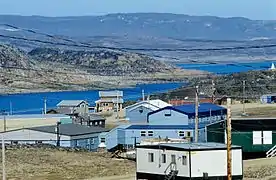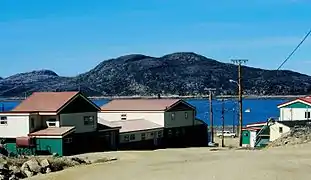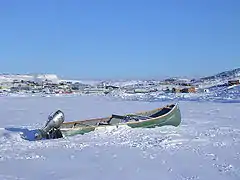Kinngait
Kinngait (Inuktitut meaning "high mountain" or "where the hills are";[5][6] Syllabics: ᑭᙵᐃᑦ), formerly known as Cape Dorset until 27 February 2020,[7] is an Inuit hamlet located on Dorset Island[8] near Foxe Peninsula at the southern tip of Baffin Island in the Qikiqtaaluk Region of Nunavut, Canada.
Kinngait
Sikusiilaq ᑭᙵᐃᑦ | |
|---|---|
 Part of the village with characteristic Kinngait hill, May 1997 | |
| Nickname(s): Capital of Inuit Art | |
 Kinngait  Kinngait | |
| Coordinates: 64°14′00″N 076°32′30″W | |
| Country | Canada |
| Territory | Nunavut |
| Region | Qikiqtaaluk |
| Electoral district | South Baffin |
| Federal Electoral district | Nunavut |
| Hudson's Bay Company | 1913 |
| Government | |
| • Type | Hamlet |
| • Mayor | Timoon Toonoo |
| • MLA | David Joanasie |
| • MP | Mumilaaq Qaqqaq |
| • Senator | Dennis Patterson |
| Area | |
| • Total | 9.74 km2 (3.76 sq mi) |
| Elevation | 50 m (160 ft) |
| Highest elevation | 243 m (797 ft) |
| Lowest elevation | 0 m (0 ft) |
| Population (2016)[3] | |
| • Total | 1,441 |
| • Density | 150/km2 (380/sq mi) |
| Time zone | UTC−05:00 (EST) |
| • Summer (DST) | UTC−04:00 (EDT) |
| Postal code | X0A 0C0 |
| Area code(s) | 867 |
History
Kinngait, previously, Sikusiilaq,[9]is where the remains of the Thule (Early Inuit) and pre-Inuit Dorset people (Tuniit) were discovered, who lived between 1000 BC and 1100 AD. The European name of Cape Dorset was given by Captain Luke Fox after Edward Sackville, 4th Earl of Dorset, on September 24, 1631. The Inuit originally called the inlet Sikusiilaq, after the area of sea ocean nearby that remains ice-free all winter. Hudson's Bay Company set up a trading post here in 1913, where they traded furs and skins for supplies such as tobacco, ammunition, flour, gas, tea and sugar.[10]
In December 2019, the residents of Cape Dorset voted in favour of a request to officially rename the hamlet to its Inuktitut name of Kinngait.[11] Voters chose between Kinngait, Sikusilaq, and the English name of Cape Dorset.
Art
Since the 1950s, Kinngait, which calls itself the "Capital of Inuit Art", has been a centre for drawing, printmaking, and carving. In the 21st century, printmaking and carving continue to be the community's main economic activities. Each year, Kinngait Studios issues an annual print collection. Kinngait has been hailed as the most artistic community in Canada, with some 22% of the labour force employed in the arts.[12]
In 1957, James Archibald Houston created a graphic arts workshop in Kinngait, in a program sponsored by the Department of Northern Affairs and National Resources. It was considered a way for the community to generate income by adapting traditional art forms to contemporary techniques.[13]:49 Houston collected drawings from community artists and encouraged local Inuit stone carvers to apply their skills to stone-block printing, in order to create art that might be more widely sold and distributed. The print program was modeled after Japanese ukiyo-e workshops. Other cooperative print shops were established in nearby communities, but the Kinngait workshop has remained the most successful. The artists have experimented with etching, engraving, lithography, and silkscreen. They produce annual catalogs advertising the limited edition prints.[13]:49
Between the years of 1959 and 1974, Kinngait artists produced more than 48,000 prints. Well-known artists of Kinngait include Pitseolak Ashoona, Nuna Parr, Pudlo Pudlat, Angotigolu Teevee, Alashua Aningmiuq, Kiugak Ashoona, Ulayu Pingwartok, Oopik Pitsuilak, Innukjuakju Pudlat, Mary Qayuaryuk, Anirnik Oshuitoq, and Kenojuak Ashevak. Parr's carvings are internationally recognized and his work is exhibited in the National Gallery of Canada. Ashevak's drawings of owls have been chosen to appear on Canadian stamps as well as a Canadian quarter.[14]
Inuit carver, artist, photographer and author Peter Pitseolak spent several years living in Kinngait. The local junior-senior high school was named for him.[15]
Below is a list of some of the artists from Kinngait, according to the Inuit Art Foundation.[16][17][18]
- Kenojuak Ashevak
- Kiugak Ashoona
- Pitseolak Ashoona
- Shuvinai Ashoona
- Kingmeata Etidlooie
- Osuitok Ipeelee
- Siassie Kenneally
- Qaunaq Mikkigak
- Qaunak Mikkigak
- Ohotaq Mikkigak
- Omalluq Oshutsiaq
- Eleeshushe Parr
- Parr
- Peter Pitseolak
- Tim Pitsiulak
- Annie Pootoogook
- Kananginak Pootoogook
- Napachie Pootoogook
- Mary Pudlat
- Pudlo Pudlat
- Lucy Qinnuayuak
- Simeonie Quppapik
- Pauta Saila
- Pitaloosie Saila
- Ningiukulu Teevee
- Ovilu Tunnillie
Demographics
As of the 2016 census, the population was 1,411, an increase of 5.7% from the 2006 census.[3]
Transportation
A handful of unnamed dirt/gravel roads (unpaved because of winter conditions) cross the village but do not connect beyond Kinngait. Cars and trucks are the main means of transportation and supplemented by snowmobiles and ATVs (all-terrain vehicles) during the winter. The people use boats and ships for seasonal travel to and from Kinngait when the Hudson Strait is ice-free. A taxi company, Tuniit Taxis, offer a range of vehicles.
The area is serviced by the Cape Dorset Airport with connections only within Nunavut. Travel outside Nunavut can be made via connections through Iqaluit Airport.
Education
The only secondary school in town, Peter Pitseolak School (PPS), was destroyed by fire set by three youths in September 2015.[19] In summer 2019, the school opened a printmaking studio workshop space for children, through the Embassy of Imagination program.[20]
Sam Pudlat School is the community's only elementary school; it has enrollment of 227 students. Attendance is good at the elementary school but quite poor at the high school.[21]
Post-secondary education is available in a limited number of areas in Kinngait at the Community Learning Centre. Nunavut Arctic College, based in Iqaluit, periodically offers community-based programs in Kinngait at the Community Learning Centre.
Community services
The Royal Canadian Mounted Police has a detachment staffed by four officers and sometimes number as many as six officers with one corporal.
The Fire Department is staffed by 25 volunteers and a pumper at a single fire hall. There is a lack of fire hydrants in the town, so each run has to be filled up at the water station.
Medical facilities are basic at the Cape Dorset Health Centre.[22] Advanced medical care requires an airlift to the 35-bed Qikiqtani General Hospital in Iqaluit.[23] There is no ambulance in the town. Qualified doctors visit only occasionally. There is a taxi service but it is not consistently reliable.
Broadband communications
The community has been served by the Qiniq network since 2005. Qiniq is a fixed wireless service to homes and businesses, connecting to the outside world via a satellite backbone. The Qiniq network is designed and operated by SSI Micro. In 2017, the network was upgraded to 4G LTE technology, and 2G-GSM for mobile voice.
Housing
No new family dwellings have been built in more than 10 years, so houses are overcrowded with as many as 17 people living in small quarters. TB or tuberculosis is active in the town. This is made more acutely dangerous as the overcrowding continues.
Food insecurity
The cost of basic food staples like milk, cheese, flour, butter is 65-75% higher than in Ottawa or Montreal.
Tourism
Spanning both Dorset Island and Mallik Island, Mallikjuaq Territorial Park is notable for archaeological sites revealing Thule culture, Dorset culture, and Inuit history. The park is reachable by foot from Kinngait at low tide, or by boat. A cairn was raised in memory of the ship, RMS Nascopie, that hit rock and sank in 1947. It was a supply ship to the Arctic. Although the cargo was lost, the passengers and crew were saved.
In September 2018, the Kenokuak Cultural Centre and Print Shop[25] opened. The centre is named after local artist and Inuit art pioneer Kenojuak Ashevak who died in 2013. The centre serves a community facility, art studio and exhibition space for local artists.
There are outfitters that provide numerous dog sledding, camping, and hiking to parks tours.
Gallery
Climate
Kinngait has a tundra climate (ET) with short but cool summers and long cold winters.
| Climate data for Cape Dorset Airport | |||||||||||||
|---|---|---|---|---|---|---|---|---|---|---|---|---|---|
| Month | Jan | Feb | Mar | Apr | May | Jun | Jul | Aug | Sep | Oct | Nov | Dec | Year |
| Record high humidex | −1.4 | 0.7 | 0.7 | 3.9 | 10.4 | 17.3 | 25.0 | 21.6 | 12.7 | 6.5 | 3.4 | 1.6 | 25.0 |
| Record high °C (°F) | −1.4 (29.5) |
2.8 (37.0) |
1.6 (34.9) |
5.6 (42.1) |
10.9 (51.6) |
17.9 (64.2) |
25.0 (77.0) |
21.9 (71.4) |
18.1 (64.6) |
7.2 (45.0) |
3.4 (38.1) |
−0.8 (30.6) |
25.0 (77.0) |
| Average high °C (°F) | −21.7 (−7.1) |
−22.2 (−8.0) |
−17.5 (0.5) |
−9.9 (14.2) |
−2.5 (27.5) |
5.3 (41.5) |
11.8 (53.2) |
9.1 (48.4) |
4.0 (39.2) |
−1.6 (29.1) |
−8.1 (17.4) |
−16.2 (2.8) |
−5.8 (21.6) |
| Daily mean °C (°F) | −25.0 (−13.0) |
−25.4 (−13.7) |
−21.2 (−6.2) |
−13.6 (7.5) |
−5.3 (22.5) |
2.4 (36.3) |
7.8 (46.0) |
5.9 (42.6) |
1.8 (35.2) |
−3.6 (25.5) |
−11.0 (12.2) |
−19.5 (−3.1) |
−8.9 (16.0) |
| Average low °C (°F) | −28.2 (−18.8) |
−28.7 (−19.7) |
−24.8 (−12.6) |
−17.2 (1.0) |
−8.0 (17.6) |
−0.6 (30.9) |
3.7 (38.7) |
2.7 (36.9) |
−0.4 (31.3) |
−5.6 (21.9) |
−14.0 (6.8) |
−22.8 (−9.0) |
−12.0 (10.4) |
| Record low °C (°F) | −38.9 (−38.0) |
−40.6 (−41.1) |
−42.2 (−44.0) |
−32.8 (−27.0) |
−19.6 (−3.3) |
−9.3 (15.3) |
−3.4 (25.9) |
−4.6 (23.7) |
−8.3 (17.1) |
−23.9 (−11.0) |
−30.6 (−23.1) |
−42.8 (−45.0) |
−42.8 (−45.0) |
| Record low wind chill | −54.5 | −58.1 | −53.0 | −44.6 | −29.3 | −14.6 | −7.0 | −8.7 | −14.7 | −39.7 | −39.7 | −51.4 | −58.1 |
| Average precipitation mm (inches) | 21.6 (0.85) |
20.9 (0.82) |
25.4 (1.00) |
29.4 (1.16) |
31.4 (1.24) |
29.5 (1.16) |
37.7 (1.48) |
53.2 (2.09) |
48.9 (1.93) |
44.9 (1.77) |
44.2 (1.74) |
31.5 (1.24) |
418.5 (16.48) |
| Average rainfall mm (inches) | 0.0 (0.0) |
0.0 (0.0) |
0.0 (0.0) |
0.3 (0.01) |
4.0 (0.16) |
20.9 (0.82) |
37.8 (1.49) |
52.1 (2.05) |
35.7 (1.41) |
7.2 (0.28) |
0.0 (0.0) |
0.0 (0.0) |
158.0 (6.22) |
| Average snowfall cm (inches) | 24.2 (9.5) |
24.2 (9.5) |
28.3 (11.1) |
32.8 (12.9) |
29.7 (11.7) |
8.5 (3.3) |
0.2 (0.1) |
1.2 (0.5) |
13.2 (5.2) |
40.1 (15.8) |
50.6 (19.9) |
37.6 (14.8) |
290.7 (114.4) |
| Average precipitation days (≥ 0.2 mm) | 16.0 | 14.5 | 15.1 | 14.6 | 15.4 | 10.3 | 11.4 | 13.5 | 15.4 | 19.0 | 19.9 | 19.1 | 184.1 |
| Average rainy days (≥ 0.2 mm) | 0.0 | 0.0 | 0.0 | 0.4 | 1.9 | 6.8 | 11.4 | 13.3 | 10.6 | 3.2 | 0.1 | 0.0 | 47.8 |
| Average snowy days (≥ 0.2 cm) | 16.0 | 14.5 | 15.3 | 14.4 | 14.6 | 4.8 | 0.1 | 0.4 | 6.9 | 17.8 | 19.8 | 19.0 | 143.6 |
| Average relative humidity (%) | 69.3 | 68.0 | 69.6 | 76.9 | 82.6 | 77.5 | 68.8 | 74.7 | 81.7 | 84.1 | 82.1 | 75.8 | 75.9 |
| Mean monthly sunshine hours | 7.6 | 72.5 | 172.6 | 215.7 | 157.0 | 220.1 | 274.1 | 187.3 | 87.4 | 45.2 | 17.6 | 0.0 | 1,457.2 |
| Percent possible sunshine | 4.5 | 30.3 | 47.5 | 47.8 | 27.5 | 35.1 | 44.9 | 36.8 | 22.2 | 14.9 | 9.0 | 0.0 | 26.7 |
| Source: Environment Canada Canadian Climate Normals 1981–2010[26] | |||||||||||||
References
- Nunavummiut vie for council positions in upcoming hamlet elections
- Results for the constituency of South Baffin Archived 2013-11-14 at the Wayback Machine at Elections Nunavut
- "Census Profile, 2016 Census". Statistics Canada. Retrieved 2017-03-03.
- Elevation at airport. Canada Flight Supplement. Effective 0901Z July 16, 2020 to 0901Z September 10, 2020.
- History of Cape Dorset Archived 2007-06-14 at the Wayback Machine
- Cohen, Sidney. "Cape Dorset council endorses vote to return community name to Kinngait". CBC News. Retrieved 26 January 2020.
- Nunavut minister signs off on name changes for two communities
- Government of Nunavut - Communities
- Cape Dorset considers changing to traditional Inuktitut name
- "Cape Dorset | Travel Nunavut". Retrieved 23 February 2019.
- "Cape Dorset votes to revert to a traditional name — Kinngait". CBC. Retrieved 18 December 2019.
- "Cape Dorset named most 'artistic' municipality", CBC
- Hessel, Ingo. Arctic Spirit: Inuit Art from the Albrecht Collection at the Heard Museum. Phoenix: Heard Museum, 2006. ISBN 9781553651895.
- "Kenojuak Ashevak: A Celebration of Sculpture and Graphics (Inuit Solo Exhibition) (May 4 - May 24, 2002)". Spirit Wrestler Gallery. Retrieved 23 February 2019.
- Burke, Travis (September 12, 2018). "School's in: New Cape Dorset high school opens 1 year ahead of schedule | CBC News". CBC.ca. Retrieved 23 February 2019.
- Foundation, Inuit Art. "List". Inuit Art Foundation. Retrieved 2020-03-09.
- Foundation, Inuit Art. "List". Inuit Art Foundation. Retrieved 2020-03-10.
- Foundation, Inuit Art. "List". Inuit Art Foundation. Retrieved 2020-03-10.
- "RCMP lay charges in fire that destroyed school in Nunavut", City News, 8 September 2015
- News, Nunatsiaq (2019-07-09). "Artistic space for youth opens in Cape Dorset". Nunatsiaq News. Retrieved 2020-03-10.
- News, Nunatsiaq (2018-09-18). "New school in Nunavut, three years after fire". Nunatsiaq News. Retrieved 2020-03-10.
- "Cape Dorset | Government of Nunavut". www.gov.nu.ca. Retrieved 2020-03-10.
- "Qikiqtani General Hospital | Government of Nunavut". www.gov.nu.ca. Retrieved 2020-03-10.
- Kenokuak Cultural Centre and Print Shop
- "Cape Dorset A" (CSV (4222 KB)). Canadian Climate Normals 1981–2010. Environment Canada. Climate ID: 2400635. Retrieved 2013-11-27.
Further reading
- Dorais, Louis-Jacques. Kinngaqmiut Uqausingit = The Inuit Language in Cape Dorset N.W.T. = Le Parler Inuit De Cape Dorset T.N.O.. Quebec: Association Inuksiutiit katimajiit, Laboratoire d'anthropologie, Université Laval, 1975.
- Leroux, Odette, Marion E. Jackson, and Minnie Aodla Freeman. Inuit Women Artists Voices from Cape Dorset. Vancouver: Douglas & McIntyre, 1994. ISBN 0-295-97389-7
- Norton, Derek, and Nigel Reading. Cape Dorset Sculpture. Seattle: University of Washington Press, 2005. ISBN 0-295-98478-3
- Nunavut Handbook, Iqaluit 2004 ISBN 0-9736754-0-3
- Pitseolak, Peter, and Dorothy Eber. People from Our Side An Eskimo Life Story in Words and Photographs : an Inuit Record of Seekooseelak, the Land of the People of Cape Dorset, Baffin Island. Bloomington: Indiana University Press, 1975. ISBN 0-253-34334-8
- Ryan, Leslie Boyd. Cape Dorset Prints, a Retrospective Fifty Years of Printmaking at the Kinngait Studios. San Francisco: Pomegranate, 2007. ISBN 978-0-7649-4191-7
- SchoolNet Digital Collections (Canada). Cape Dorset Inuit art and Inuit cultural perspectives. Ottawa: Industry Canada, 2000.
- Walk, Ansgar. Kenojuak - The Life Story of an Inuit Artist. Manotick: Penumbra Press, 1999. ISBN 0-921254-95-4
External links
| Wikimedia Commons has media related to Cape Dorset. |
- Cape Dorset Artists
- Cape Dorset homepage
- The Cape Dorset Prints from the Library and Archives of Canada
- Archives: Finding Aids: Kinngait from the Inuit Art Foundation
- "A Family of Artists Creates a Portrait of Inuk Life Across Three Generations" from Hyperallergic




